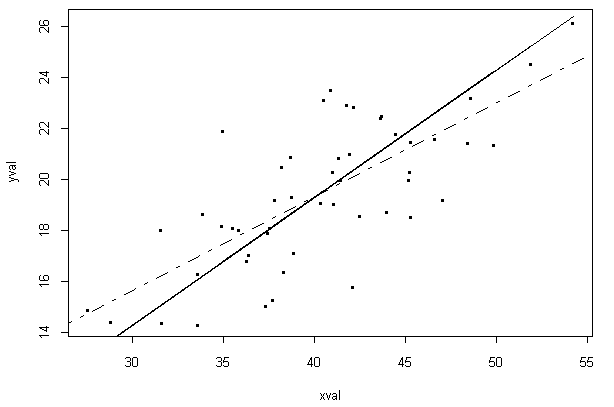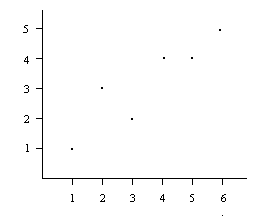Top
Math 147 - Fall 1997 - Test # 2
Name: _______________________________________ Section Number: _____________________
Show ALL your work. Solutions with no work will receive NO credit. NEATNESS COUNTS! If you need extra paper, use the back page or raise your hand and ask one of the proctors for some. A normal table is provided at the end of the test.
For questions 1 - 8 circle the answer which best completes the sentence. ( 3 points each)
- In a regression setting for predicting y from x, a correlation coefficient of zero means,
- the R.M.S. error is equal to the SD of x.
- there is no relationship between the variables.
- the slope of the regression line is zero.
- the slope of the SD line is zero.
- both (b) and (c).
- In a regression setting for predicting y from x a correlation coefficient of - 0.92 indicates,
- x and y have a strong linear relationship.
- large values of x are generally associated with large values of y.
- large values of x are generally associated with small values of y.
- both (a) and (b).
- both (a) and (c).
- You are told by a scientist that fitting a regression line to her research was appropriate. You expect,
- the residual plot of the regression shows no pattern.
- the regression line for the residuals has the same slope as the SD line.
- the value of r for her data set was very close to 1 or - 1.
- her scatter diagram contains two distinct clusters of points.
- none of the above.
- Consider the following statements about a regression setting for predicting y from x:
- The units for the correlation coefficient are the same as the units of y.
- The correlation coefficient will not change if all the values of one variable are multiplied by - 1.
- The units for the R.M.S. error are the same as the units of x.
- If the x and y variables are switched then the value of the correlation coefficient changes sign.
Then we know,
- I and II are true.
- II and IV are true.
- II and III are true.
- all of the above statements are true.
- none of the above statements are true.
- When we use the method of vertical strips to estimate percentages about a sub-population we should
remember,
- the spread within the vertical strips of the scatter diagram should be similar.
- the new average is a point directly on the regression line.
- the pattern of the scatter diagram should be homoscedastic.
- both (a) and (b).
- all of the above.
- Let A and B be two events. If we know the probability A occurring, and we know the probability of B occurring, then we can find,
- the probability that at least one of A or B occurs if we know they are mutually exclusive.
- the probability of event B occurring given A has occurred if we know the probability of A and B both occurring.
- the probability that both A and B occur if they are mutually exclusive.
- both (a) and (b).
- all of the above.
- A deck of cards is shuffled and the top card placed on a table. The deck is then shuffled again and the
top card is placed on the table next to the other card. It is true that,
- the chance that the second card is a king is smaller if we know the first card is a king.
- the chance that the second card is a heart is 13/51.
- the events "the first card is a heart" and "the second card is a spade" are independent.
- both (a) and (b).
- all of the above .
- If we know that event A and event B are dependent, we can say with certainty that,
- event A and event B cannot both occur.
- the probability of B occurring given that A has occurred is greater than the probability of B occurring.
- the probability of A and B occurring is the probability that A occurs times the probability that B occurs given that A has occurred.
- both (b) and (c).
- none of the above.
9. ( 14 points) Note the following scatter diagram.

Use the above diagram to complete the paragraph below. In each set of bold choices, circle the answer which best fits in the paragraph.
The above figure is a scatter diagram of two variables. The solid / dashed line represents the SD line,
while the solid / dashed line represents the regression line. The SD of Y is about 2.8, 4.8, 6.8 while the
SD of X is about 2.6, 5.6, 8.6. Looking at the figure, we can see that the correlation coefficient for this
set of data is about -0.99, -0.75, 0, 0.75, 0.99. If we observe an x-value of 30, our prediction of the
y-value is 14.3, 15.6, 17. The R.M.S. error of this scatter diagram is about 1.8, 3.8. The point ( 31, 18 )
is on the scatter diagram, and the residual for this point is about -3.0, -2.0, -1.0, 1.0, 2.0, 3.0.
- ( 10 points) Using the graph and information given, complete the table below. Place only the final
answer in the table, doing any relevant work below it. Round all answers to the nearest hundredth
[ two decimal places].

Ave. of x-values = 3.5, SD = 1.87
Ave. of y-values = 3.17, SD = 1.47
|
x |
y |
x in standard units |
y in standard units |
product |
|
1 |
1 |
|
-1.48 |
|
|
2 |
3 |
-0.80 |
-0.80 |
0.64 |
|
3 |
|
-0.27 |
-0.12 |
0.32 |
|
4 |
4 |
0.27 |
0.56 |
0.15 |
|
5 |
4 |
0.80 |
0.56 |
0.45 |
| |
5 |
1.34 |
|
|
We can now use the above table to compute r =
- A medical researcher who is examining patients as part of a study on heart disease conducts an
experiment on a group of males involving jogging on a treadmill and recording the number of minutes
that the subject could maintain a fixed speed. The researcher summarized his experiment statistically
as follows:
Weight of subject ( pounds) Ave. = 180 SD = 24
Time on treadmill ( minutes) Ave. = 40 SD = 10, r = - 0.6
The scatter diagram is football shaped.
- (6 points) Find the equation of the regression line for predicting time on the treadmill from weight.
- ( 3 points) Fred weighs 192 pounds, estimate the time that he could jog on the treadmill.
- (4 points) Calculate the R.M.S. error for predicting time on treadmill from weight
- (7 points ) Approximately what percentage of males who weigh 192 pounds can be expected to jog longer than 49 minutes on the treadmill?
(e) ( 4 points) Approximately what percentage of males can be expected to jog longer that 50 minutes?
- ( 3 points) How long would you expect Bill (whose weight you do not know) to jog on the treadmill?
- (3 points) Consider the following statement and answer the question below:
For someone who weighs 340 pounds it is reasonable to use the line to predict a jogging time
of 0 minutes.
Is this statement True or False. Explain briefly.
- Consider the following two boxes:
|
R2 |
R2 |
B1 |
B1 |
B3 |
|
G2 |
G1 |
G1 |
G3 |
G3 |
Box A (10 Tickets)
Box B (8 Tickets)
Each ticket in the boxes has both a color and a number on it. The key for the color is as follows:
R = Red, B = Blue, G = Green. Answer the following questions below based on the contents of the boxes.
- ( 3 points) One ticket is drawn from Box A. What is the conditional probability that the ticket is green given that it has a three on it?
- ( 3 points) Two tickets are drawn from Box B without replacement. What is the probability that the first ticket is red and the second ticket is blue?
- ( 6 points) Two tickets are drawn from Box A with replacement. What is the probability that the sum of the numbers on the tickets is 4?
- ( 4 points) One ticket is drawn from Box A and one from Box B what is the conditional probability
the number on the ticket from box B is greater than or equal to the number drawn from Box A, given
that the ticket drawn from Box A is red?
- ( 2 points) Color and number are independent in Box A. (just answer yes or no)
(e) ( 2 points) Color and number are independent in Box B. (just answer yes or no)
- (2 points) The events "drawing a red ticket" and "drawing a ticket with a two on it" from Box A are
mutually exclusive. ( just answer yes on no)
| Top | Home |Answer Key |


